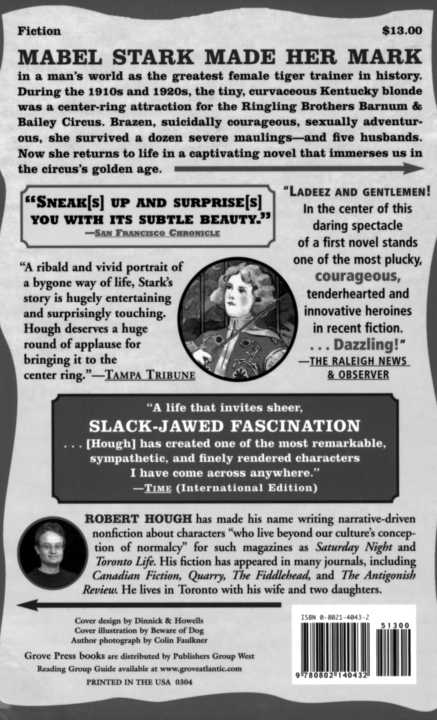The Final Confession of Mabel Stark: A Novel (An Evergreen book) (60 page)
Read The Final Confession of Mabel Stark: A Novel (An Evergreen book) Online
Authors: Robert Hough

I massaged a couple of minor facts in service of the story, which
I will mention as there are many circus aficionados out there, and it is
not my wish to anger them. There were not one but two Rajahs
(named, incidentally, Rajah I and Rajah II). As the first was by far the
most important to her career, I eliminated the second. Second, Mabel
Stark did marry one more time, for a few years in the early sixties, to
another old menage boss named Eddie Trees. Finally, Al G. Barnes
died in the state of California, and not in Oregon.
The Al G. Barnes Circus performed its last date on November 27,
1938, in Sarasota, Florida, on a bill shared with Sells-Floto, John
Robinson and the Ringling Brothers Barnum & Bailey Circus.
On July 6, 1944, during a show in Hartford, Connecticut, the
paraffin coating a Ringling big top caught fire, killing 168 patrons. For
years, the show survived in a state of near-bankruptcy, owing to damages awarded against it. Today, the Ringling Circus is the biggest in the
world and tours the United States and Canada in two units.
Mabel Stark committed suicide on April 21, 1968, through a combination of self-asphyxiation and barbiturate overdose. Her exact age
was unknown.
While many people assisted with the research of this novel, there are
five individuals without whose help this book would not have been possible. Roger Smith of Houston, upon whom the Roger Haynes character is based, helped immensely with my depiction of Mabel Stark in her
later years. Fred Dahlinger, head librarian at Circus World Museum,
unhesitatingly shipped me numerous old circus books, many of them
fifty years out of print, with nothing more than my promise to return
them unharmed. Michael Hackenberger, an animal trainer and owner of
the Bowmanville Zoo in Bowmanville, Ontario, taught me many of the
early training techniques presented in the book. Al Stencell, an ex-circus
owner and girl show expert, told me everything I'd ever need to know
about cooch dancing. Finally, Barbara Byrd, of the Carson & Barnes
Circus, invited me to travel for a week with her circus through rural
Texas, even though I made it clear I would not, in any way, be able to
promote her show with my book; this, I submit, is what troupers mean
when they describe someone as being "both with it and for it."
I'd also like to thank those who read the book and offered
suggestions along the way: Susan Greer, Jackie Kaiser, Jocelyn
Lawrence, Jan Whitford and Robert Young. My thanks also goes to
those who've supported my writing in the past, either by giving me
magazine gigs or critiquing earlier, unpublishable works of long fiction:
Lynn Cunningham, Angie Gardos, Wayne Gooding, Angel Guerra,
Marni Kramarich, John Macfarlane, Dianna Symonds, Linda Williams.
Finally, my complete and unreserved gratitude goes to my editor, Anne
Collins, who upon receiving highly abbreviated, yet-to-be-fleshed-out
drafts never failed to say what a writer most wants to hear:
"It's getting there. Now give me more."

